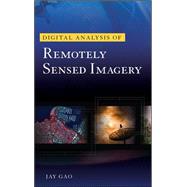Digital Analysis of Remotely Sensed Imagery
, by Gao, Jay- ISBN: 9780071604659 | 0071604650
- Cover: Hardcover
- Copyright: 1/12/2009
"Jay Gao's book on the analysis of remote sensing imagery is a well-written, easy-to-read, and informative text best serving graduate students in geosciences, and practitioners in the field of digital image analysis. Although Dr. Gao states that he has targeted his book at upper-level undergraduates and lower-level postgraduate students, its rigor and depth of mathematical analysis would challenge most students without prior experience in remote sensing and college-level mathematics. The book covers a lot of ground quickly, beginning with a basic explanation of pixels, digital numbers and histograms and advancing rapidly through a description of the most well-known satellite systems to data storage formats, rectification and classification. It best serves students who have already taken an introductory course in remote sensing. Following a three-chapter description of the basics the remaining eleven chapters are dedicated to the description of the most common image processing systems and the details of the image analysis functions which can be carried out. The largest portion of the text covers classification spectral and spatial, neural networks, decision trees and expert systems and is an invaluable reference to anyone interested in understanding image analysis terminology and the algorithms behind these different systems. The last chapter of the text is addressed to practitioners wishing to integrate remote sensing image data with GIS and/or GPS data. The text is nicely structured so that individual chapters can easily be skipped when their content is not of interest to the reader without impairing the understanding of later chapters."The first three chapters of the book cover introductory material that the reader should be familiar with for the most part, but also includes a very handy summary of today's satellite systems. Chapter one addresses basic material, such as pixel DN, coordinates, feature space, histograms, and spatial, spectral, temporal and radiometric resolution normally covered in an introductory course in remote sensing. Chapter two presents a very informative and up-to-date overview of today's satellite instruments including meteorological, oceanographic, earth resources, hyperspectral and radar instruments. Instrument and orbital parameters are presented in tabular form and make it easy to look up technical details such as spectral and spatial resolution, orbit type, repeat cycle and other instrument characteristics quickly. Written explanations are clear, readable and provide lots of interesting insight and useful tidbits of information such as potential problems and the cost of imagery. For technicians and programmers the third chapter provides details on storage formats, including descriptions of BSQ, BIL and BIP binary formats, and the most common graphics formats like GIF, TIFF and JPEG together with data compression techniques. Non-technicians can skip this chapter since image processing software will generally take care of format conversions internally without a need for understanding the nuances of each."Chapters four will be of interest to anyone considering the purchase of image processing software, or trying to understand the differences between systems. Gao provides a useful overview of existing software IDRISI, ERDAS Imagine, ENVI, ER Mapper, PCI, eCognition and GRASS. A brief history of each provides useful background, and a discussion of the features of each together with a comparison (also given in tabular form) is informative to anyone considering a purchase."Chapter five can also be viewed as a stand-alone reference on rectification, but also serves as an excellent overview of the problems of dealing with mapping on a curved surface and has particular application for geographers and cartographers. It discusses the sources of geometric distortion, coordinated systems and projections, how image rec







